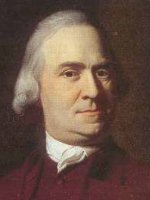The Real Samuel Adams and Real Life
 I’ve been tracing the idea that Samuel Adams somehow instigated the shooting at Lexington on 19 Apr 1775, from the first suggestion by Harold Murdock through the development by Arthur Bernon Tourtellot to a recent elaboration by William H. Hallahan. I see three major holes in this thesis, even beyond the lack of any positive evidence for it whatsoever.
I’ve been tracing the idea that Samuel Adams somehow instigated the shooting at Lexington on 19 Apr 1775, from the first suggestion by Harold Murdock through the development by Arthur Bernon Tourtellot to a recent elaboration by William H. Hallahan. I see three major holes in this thesis, even beyond the lack of any positive evidence for it whatsoever.
First, this theory writes off the fact that the Revolution was a mass movement. It involved hundreds of thousands of people. It was organized through committees, conventions, congresses, and other means of collective decision-making. Since the Powder Alarm of early September 1774, the Boston Whigs had realized that the Massachusetts countryside was more eager to fight than their own town.
Even among the political leaders of Massachusetts, Adams was only the foremost of a large group. Some twentieth-century writers gave him credit or blame for everything that happened in Boston and then in eastern Massachusetts. But Adams didn’t come to prominence until after 1765. He had a lot of colleagues in Boston, some of them (William Molineux, Dr. Thomas Young) much closer to the crowds than he was. He was pulled along by many significant events, and far away from some others. It’s foolish to believe that Adams was guiding every political development of the day.
Second, Adams’s contemporaries considered him to be a cautious politician, especially when it came to violence. There’s no strong evidence that he led mobs. James Otis, Jr., reportedly trusted Adams—and only him—to keep him from speaking too rashly. Adams’s writings show a consistent belief that there was no need for dramatic actions. Rather, he usually stated that steady unity and resolve would cause royal officials to back down or reveal their true tyrannical aims.
Thus, on 21 May 1774, Adams wrote from Philadelphia to James Warren:
I beseech you to implore every Friend in Boston by every thing dear and sacred to Men of Sense and Virtue to avoid Blood and Tumult. They will have time enough to dye. Let them give the other Provinces opportunity to think and resolve.Even as he itched for independence, Adams wrote to the Rev. Dr. Samuel Cooper on 30 Apr 1776:
Rash Spirits that would by their Impetuosity involve us in unsurmountable Difficulties will be left to perish by themselves despisd by their Enemies, and almost detested by their Friends. Nothing can ruin us but our Violence. Reason teaches this. I have indubitable Intelligence, dreadful, as to the Designs against us; consolatory, if we are but prudent.
Indeed I have the Happiness of believing that what I most earnestly wish for will in due time be effected. We cannot make Events. Our Business is wisely to improve them.To believe that Adams had indeed “made Events” in Lexington is to believe that he was completely duplicitous about his philosophy throughout life, even with his closest colleagues.
Furthermore, all the eyewitness testimony we have about Adams’s actions in the early hours of 19 Apr 1775 says that he spoke against confronting the troops. He urged leaving the Lexington parsonage as quickly and quietly as possible. Dolly Quincy reportedly heard him tell her future husband as the royal army approached, “that is not our business. We belong to the Cabinet.” In other words, elected officials had the responsibility to stay away from possible violence and keep the government running.
The third weakness of the Murdock/Tourtellot hypothesis is that it’s a conspiracy theory: a secret agreement among Adams, local minister Jonas Clarke, and militia captain John Parker to carry out a complex plot. That scheme depended on a precise understanding of how the Lexington militiamen would behave if ordered to stand on the Green, how the British troops would respond, and how the people of Massachusetts would respond in turn. The hypothesis requires nearly every action that men took in the early hours of 19 Apr 1775 to be the result of planning, and not just habit or circumstance. It posits a plot that men considered noble yet kept completely secret for decades.
(Hallahan’s wild tangent off the Murdock/Tourtellot hypothesis is even more clearly a conspiracy theory: in addition to those actions and reactions, it also posits a secret agreement between Adams and an unidentified gunman.)
One of the wisest rules for making sense of life, either in the present or in the past, is never to come up with a conspiracy theory for what can be explained by incompetence. (For variations on this dictum, see “Hanlon’s razor” and the words of Sir Bernard Ingham.) The British reports on the Concord march and the depositions from American veterans in the 1820s and 1830s offer little evidence of a conspiracy. But they show lots of evidence of incompetence, or rather of the limits on human competence: incomplete knowledge, inaccurate assumptions, misunderstandings, hesitations, poor memory, fatigue, compromises, circumstances beyond people’s control. In other words, real life.
TOMORROW: Which Patriot leader really called for standing up to the regulars.

1 comment:
Thanks for your praise! And yes, Paul Revere’s Ride does a very convincing job at portraying that day. It’s a good book to reread!
Post a Comment